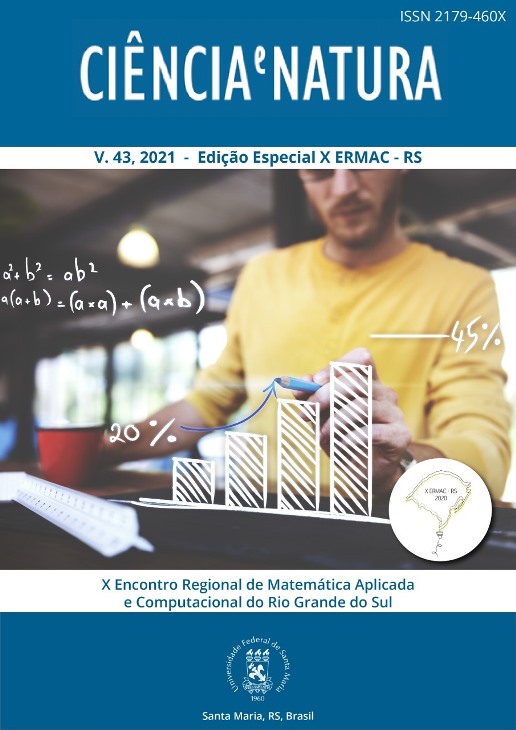Padrões espaciais de agregação populacional em modelos discretos
DOI:
https://doi.org/10.5902/2179460X66992Palavras-chave:
Agregação, Formação de padrões espaciais, Movimentação dependente da densidade, Redes de mapas acopladosResumo
Diversos modelos matemáticos são utilizados para tentar descrever a formação de distribuições heterogêneas de indivíduos de muitas espécies. Com este intuito, são propostos neste trabalho dois modelos de redes de mapas acoplados com movimentação dependente da densidade. O primeiro modelo considera que os indivíduos possuem apenas uma percepção local enquanto o segundo pressupõe uma percepção não local. Em ambos os modelos, é adotada uma preferência dos indivíduos por densidades intermediárias, protegendo-se dos riscos gerados pela superpopulação ou pela dificuldade de manter a espécie em locais pouco povoados. Foram realizadas simulações dos dois modelos, obtendo distribuições espaciais homogêneas, heterogêneas estáveis, heterogêneas oscilatórias e instáveis. Foi possível concluir que ambos os modelos representam mecanismos de agregação e que os modelos com percepção não local possibilitaram a formação de padrões mais extensos.
Downloads
Referências
Comins, H. N., Hassell, M. P., May, R. M. (1992). The spatial dynamics of host-parasitoid systems. Journal of Animal Ecology, pp. 735–748.
Liu, Q. X., Doelman, A., Rottschäfer, V., Jager, M., Herman, h. e. p. e. e. d. h. M. J., Rietkerk, M., van de Koppel, J. (2016). Phase separation driven by density-dependent movement: a novel mechanism for ecological patterns. Physics of life reviews, 19, 107–121.
Turchin, P. (1989). Population consequences of aggregative movement. Journal of Animal Ecology, 58, 75–100.
Publicado
Como Citar
Edição
Seção
Licença
Copyright (c) 2021 Ciência e Natura

Este trabalho está licenciado sob uma licença Creative Commons Attribution-NonCommercial-ShareAlike 4.0 International License.
Para acessar a DECLARAÇÃO DE ORIGINALIDADE E EXCLUSIVIDADE E CESSÃO DE DIREITOS AUTORAIS clique aqui.
Diretrizes Éticas para Publicação de Revistas
A revista Ciência e Natura está empenhada em garantir a ética na publicação e na qualidade dos artigos.
A conformidade com padrões de comportamento ético é, portanto, esperada de todas as partes envolvidas: Autores, Editores e Revisores.
Em particular,
Autores: Os Autores devem apresentar uma discussão objetiva sobre a importância do trabalho de pesquisa, bem como detalhes e referências suficientes para permitir que outros reproduzam as experiências. Declarações fraudulentas ou intencionalmente incorretas constituem comportamento antiético e são inaceitáveis. Artigos de Revisão também devem ser objetivos, abrangentes e relatos precisos do estado da arte. Os Autores devem assegurar que seu trabalho é uma obra totalmente original, e se o trabalho e / ou palavras de outros têm sido utilizadas, isso tem sido devidamente reconhecido. O plágio em todas as suas formas constitui um comportamento publicitário não ético e é inaceitável. Submeter o mesmo manuscrito a mais de um jornal simultaneamente constitui um comportamento publicitário não ético e é inaceitável. Os Autores não devem submeter artigos que descrevam essencialmente a mesma pesquisa a mais de uma revista. O Autor correspondente deve garantir que haja um consenso total de todos os Co-autores na aprovação da versão final do artigo e sua submissão para publicação.
Editores: Os Editores devem avaliar manuscritos exclusivamente com base no seu mérito acadêmico. Um Editor não deve usar informações não publicadas na própria pesquisa do Editor sem o consentimento expresso por escrito do Autor. Os Editores devem tomar medidas de resposta razoável quando tiverem sido apresentadas queixas éticas relativas a um manuscrito submetido ou publicado.
Revisores: Todos os manuscritos recebidos para revisão devem ser tratados como documentos confidenciais. As informações ou ideias privilegiadas obtidas através da análise por pares devem ser mantidas confidenciais e não utilizadas para vantagens pessoais. As revisões devem ser conduzidas objetivamente e as observações devem ser formuladas claramente com argumentos de apoio, de modo que os Autores possam usá-los para melhorar o artigo. Qualquer Revisor selecionado que se sinta desqualificado para rever a pesquisa relatada em um manuscrito ou sabe que sua rápida revisão será impossível deve notificar o Editor e desculpar-se do processo de revisão. Os Revisores não devem considerar manuscritos nos quais tenham conflitos de interesse resultantes de relacionamentos ou conexões competitivas, colaborativas ou outras conexões com qualquer dos autores, empresas ou instituições conectadas aos documentos.






